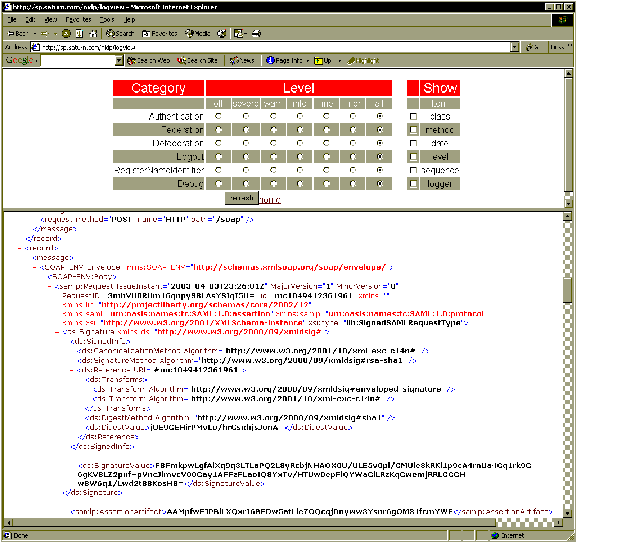Filter Options and Log File Entries

Liberty also includes a number of other log files created during Web application initialization. These files can also be used to figure out whether your issue is an Apache, Tomcat, iManager or Liberty problem, which can help you to pinpoint the source of your problem.
You can also enable Advanced Logging as part of your troubleshooting process. For details on how to do this, see Enabling Advanced Logging .
The following three files are created after the Liberty IDP installation has completed:
1. logs: These files are located by default at C:\Program Files\Novell\Tomcat\logs\*. as you run the Web applications, you might trigger errors that throw exceptions in Tomcat. Typically, information about these types of errors is displayed in your Web browser window as you view your Web applications. For example, you might view an error similar to the following:
Error: 500Location:/nidp/soapInternal Servlet Error:org.apache.jasper.compiler.CompileExceptions: <and so on>
at org.apache.jasper.compiler.JspParseEventListener.handleDirective <and so on>
at org.apache.jasper.compiler.DelegatingListener.handleDirective <and so on> . . .
Tomcat's error logs are excellent resources for troubleshooting these types of errors. The logs provide additional information from Tomcat and the JavaSDK that is not provided in the results that are returned to the Web browser window. If you explore the \Tomcat\logs\ directory on your system, you see four files by default (after adding the Liberty applications, you will see more, which are referenced separately below):
catalina_log.<date>.txt
localhost_admin_log.<date>.txt
stderr.log
stdout.log
You should start troubleshooting these files by reviewing the stderr.txt and stdout.txt files, where errors from the Java Virtual Machine are logged.
NOTE: You must stop Tomcat before you can open the log files with WordPad. If Tomcat is running, it is possible to open the log files with NotePad, since NotePad does not check to see if the opened file is in use. However, do not save the file to itself, as this will overwrite any new information added to the log file since you opened it.
If you do not locate an error listed in these files, proceed to the other logs. All the logs are text files, so you can view them with Notepad or Wordpad.
IMPORTANT: The log files will be rotated daily as you use Tomcat. You might want to occasionally delete the old logs to free up space on your system. You might also want to delete the logs as you try to troubleshoot errors in the Liberty applications, since new errors are easier to find in a fresh log file.
If Tomcat successfully loads, you should see no errors, as shown in the following messages:
Bootstrap: Create Catalina server
Bootstrap: Starting service
Starting service Tomcat-Standalone
Apache Tomcat/4.1.18
Novell JClient 1.1.1114-1.1.1114. Copyright 1999 Novell Inc. All Rights Reserved.
Bootstrap: Service started
2. iManager_eMFrame_log.<date>: This log file, located by default at C:\Program Files\Novell\Tomcat\logs\iManager_eMFrame_log.<date>, generates a list of events that occur when the iManager application is being initialized. There should be no exceptions reported in this file. A successful initialization would normally result in the following entry at the end of the file:
2003-04-03 14:31:40 StandardManager[/eMFrame]: Seeding random number generator class java.security.SecureRandom
2003-04-03 14:31:42 StandardManager[/eMFrame]: Seeding of random number generator has been completed
2003-04-03 14:31:42 StandardWrapper[/eMFrame:default]: Loading container servlet default
2003-04-03 14:31:42 StandardWrapper[/eMFrame:invoker]: Loading container servlet invoker
3. iManager_log.<date>: This log file, located by default at C:\Program Files\Novell\Tomcat\logs\iManager_log.<date>, describes the state of all Web-based applications during the Tomcat initialization. You will see eMFrame and NIDP contexts being referenced here. You should check to make sure that no errors are reported. The Liberty NIDP and NWT Web-based applications should load without errors or exceptions.
You can enable Advanced Logging on the IDP to log all requests in and out of the IDP server.
This logging feature is not enabled by default, since it can quickly fill up your hard disk with information. You should only use it to troubleshoot problems that are specific to the IDP, and you should disable this feature when you have completed your troubleshooting.
To enable the IDP logging, go to the web.xml file (found in your C:\Program Files\Tomcat\nidp\WEB-INF) and uncomment out the following entries, as shown below:
<!-- ======================================================================== Uncomment this entry and the entry below (LogLevel) for debugging ========================================================================--> <context-param> <param-name>LogFile</param-name> <param-value>LibertyLog.xml</param-value> </context-param> <!-- ======================================================================== Uncomment this entry and the entry above (LogFile) for debugging The supported LogLevels are: severe, warning, info, fine, finer, finest ========================================================================--> <context-param> <param-name>LogLevel</param-name> <param-value>finest</param-value> </context-param>
This will create the libertlog.xml file in the same directory. We recommend that you use a browser to view and filter content from this file. If you point your browser to the IDP server (/nidp/viewlog), you will get the following screen, which displays filter options and log file entries.
Figure 30
Filter Options and Log File Entries